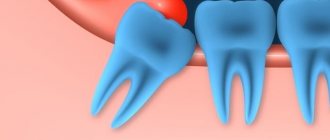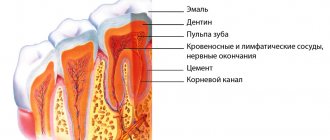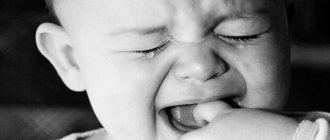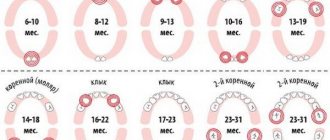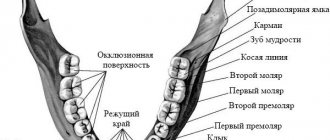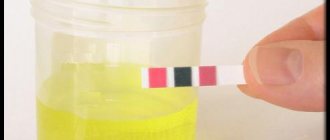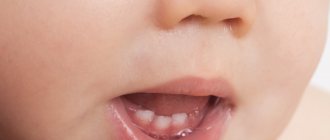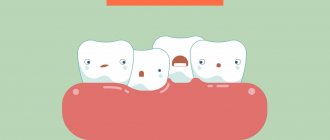Teething in infants and older children is no different: the gums swell, a white spot appears, a tooth emerges, followed by a second one (they appear in pairs).
The only difference is that older children can tell where it hurts and what is wrong, but infants need to be constantly monitored in order to quickly detect approaching teeth and help them grow calmly.
In this article we will talk about the procedure for teething in infants, the main symptoms and ways to make this process more relaxed.
How babies teeth cut: timing and development factors
The foundation of baby and permanent teeth is laid during pregnancy: their health is directly affected by the lifestyle and health of the mother.
After the birth of a child, minerals accumulate in his body, which will become building materials for teeth. The first of them appears when the baby is six months old - this happens in most situations.
But there are many cases where a child was born with a pair of ready-made teeth, or vice versa, when teeth appeared after the first year of life. This is normal: the process is influenced by many factors - from food to place of residence.
In total, nature plans 20 milk teeth. They appear in pairs, so teething in infants is usually divided into 10 stages:
- First (medial) lower incisors - 6-10 months.
- First (medial) upper incisors - 8-12 months.
- Second (lateral) upper incisors - 9-13 months.
- Second (lateral) lower incisors - 10-16 months.
- First upper molars - 13-19 months.
- First lower molars - 14-18 months.
- Upper canines - 16-22 months.
- Lower canines - 17-23 months.
- Second lower molars - 23-31 months.
- Second upper molars - 23-31 months.
From 3 to 6 years old, a temporary bite forms in the child’s mouth: it changes when the baby teeth begin to fall out. A temporary bite has a huge impact on a permanent one, and a person’s smile, which will be with him all his life, depends on its correctness.
Along with 20 milk teeth, the roots of 16 permanent teeth appear. The rest grow up at a later age.
We emphasize once again that deviations from the schedule are normal, even within a few months. To be sure, consult your pediatric dentist.
Teething
According to the tradition of many peoples of the world, there is a custom of giving gifts to a child on the occasion of the appearance of the first tooth. This ritual symbolizes wishes to the baby for health, happiness and long life. The appearance of a baby’s first tooth is a solemn moment for relatives and parents, but at the same time, teething can also be a “restless” period for parents and the baby. I would like to reassure parents and orient them to the fact that teething is a physiological process and must be approached philosophically. As if it were inevitable. And timely and correct teething is a guarantee of a healthy future child.
What is teething?
Teething is the process of vertical movement of a tooth from its origin and development within the jaw until a crown appears in the oral cavity. The process of teething begins after the crown has finally formed and is accompanied by its further development and growth of the jaw bones. Signs of physiological teething are: timeliness, sequence of eruption of certain groups of teeth and pairing.
There are temporary teeth (more often called milk teeth) and permanent teeth. According to the number of teeth, the primary teeth are 20, the permanent bite is 32 teeth. According to modern data, the period for the eruption of the first temporary teeth is usually considered to be from 4 months. The end of eruption is 3-3.5 years. Most often, the first teeth appear at the age of 6 months, and as a rule, the teeth on the lower jaw erupt first - the central incisors, then the lateral incisors, canines and molars. The timing of teething can vary from 4 months to 2 years (early teething) or from 8-10 months to 3.5-4 years (late teething).
Average time for eruption of primary teeth according to (R. Illingworth, 1997)
| tooth | Timing of eruption (month of life) | |
| Lower jaw | Upper jaw | |
| Central incisor | 6 | 7,5 |
| Side cutter | 7 | 9 |
| First molar (chewing group of teeth) | 12 | 14 |
| Fang | 16 | 18 |
| Second molar (chewing group of teeth) | 20 | 24 |
It should be noted that the quality of nutrition, sanitary and hygienic conditions and pathological conditions of the child (rickets, hypovitaminosis, intoxication, states of oxygen starvation, the nature of feeding, etc.) significantly affect the process of teething. For example, disordered teething with disruption of the time intervals between groups of teeth, delayed eruption may be a manifestation of a pathology such as rickets.
Adverse effects during teething
Temporary teeth are not permanent, that’s why they are called that. As the child grows and develops, after a certain period of time, all 20 primary teeth will be replaced. As an exception, in individuals, milk teeth do not change, remaining in adulthood (most often this occurs due to the absence of the rudiments of permanent teeth).
When primary teeth erupt, the child is in a state of “stress” and can often manifest itself with general somatic disorders. The first signs of teething, often the main ones, are the appearance of swelling of the mucous membrane of the gums in the projection of the erupting teeth. Profuse salivation appears, the child may be irritated and tearful. The eruption of central teeth often occurs without any manifestations, except for swelling of the gums and profuse drooling. When the chewing group of teeth erupts and a larger area of the gum mucosa is involved, a secondary infection may occur if the resistance of the child’s body decreases. Symptoms such as increased body temperature, upset bowel movements, redness of the mucous membrane of the gums in the mouth, decreased appetite may appear. To relieve the annoying itch, the child begins to “drag” fingers and various objects into the mouth (toys, sucking the edge of clothing, a blanket) to scratch gums, thereby can damage and infect the mucous membrane. Which can manifest itself as erosive rashes. And aggravate this condition.
How can you help your child when they are teething?
To relieve itching of the gums in a child, it can be recommended to give hard vegetables or fruits (peeled apples, carrots), or a crust of bread to chew. It is good to massage the gums with special “teether” rings or a toothbrush (silicone, or a regular baby brush with soft bristles). Some rings can be pre-cooled, but you should carefully inspect these devices and purchase them in special places in order to avoid counterfeit, uncertified goods and subsequently not harm the baby’s health, so that the child does not get hurt. If the temperature rises, antipyretic drugs can be given. To reduce the sensitivity of the mucous membrane and reduce pain in pharmacies, pharmaceutical manufacturers offer special anesthetic gels for topical use. But we recommend using these drugs only as prescribed by a doctor, so as not to cause allergies in the baby and not miss more severe complications. Contact a pediatric dentist who will conduct an examination and give qualified prescriptions to improve your well-being.
Changing temporary teeth
Permanent teeth most often appear between 5.5 and 7 years of age. Their eruption practically occurs in the same sequence as temporary teeth. The lower central incisors appear first, then the upper central incisors, and in parallel, and sometimes earlier, the first large molars erupt (the first molars, or by their number, they are called “sixths”). Please note: The sixth teeth do not fall out! They should serve your child for life. Parents mistake them for temporary teeth, which is a misconception, especially in the case of absence or poor oral hygiene and damage to this group of teeth. Which can lead to a disastrous result – tooth loss. But this group of teeth - the “First molars” - are fundamental in the formation of a correct bite; they are also called the key of occlusion. The shape of permanent “young” teeth differs from more mature ones. The cusps and cutting edges of the crowns are more pronounced, especially the cutting edges of the central teeth have a scalloped (wavy edge), the size of a permanent tooth differs from a temporary tooth, it is larger. Some parents are alarmed by this fact. To which we answer, there is no reason to worry, literally a year after eruption, the enamel edge will become even and even. And regarding the size of the crowns of the teeth, while the child is small (the appearance of the first permanent teeth is 5.5-6 years old) relative to the facial skeleton, there is a certain disproportion; as the bones of the facial region grow and develop, a harmonious relationship between the face and teeth occurs.
Average time for the eruption of permanent teeth in children (according to Schroder, 1991)
| tooth | Timing of eruption (child's year of life) | |
| Lower jaw | Upper jaw | |
| Central incisor | 6-7 | 7-8 |
| Side cutter | 7-8 | 8-9 |
| Fang | 10-12 | 11-13 |
| First premolar (small molar) | 10-11 | 9-10 |
| Second premolar (small molar) | 11-12 | 10-11 |
| First molar | 5-6 | 6-7 |
| Second molar | 12-13 | 12-14 |
| Third molar (wisdom tooth) | 15 and older | 15-16 and older |
1. In order for the teeth to last a long time and not have to “say goodbye” before the appointed time, they need careful care when they erupt.
2. Go ahead for a consultation with a pediatric dentist, who will select age-appropriate hygiene products (toothbrush and toothpaste) for your child. He will provide training in teeth brushing techniques.
3. Brush your child’s teeth at least 2 times a day (in the morning after breakfast and in the evening before bed). Helping clean hard-to-reach areas from an early age
4. Limit your child’s consumption of carbohydrate-containing foods (we do not recommend eating sweets for children under 3 years old)
5. If a child drinks liquid drinks before bed or at night, they must be replaced with regular drinking water, without added sugars.
6. The use of toothpastes containing fluoride is very important for children of the Khanty-Mansiysk Autonomous Okrug-Ugra
7. Visit the dentist 2 times a year!!!
The article was prepared by: pediatric dentist Malakhova A.A. Head of TOD - Mokrinskaya N.G.
Photos used in the article from satyov:
1. https://ladyspecial.ru
2. https://otvetymamam.ru
Signs of teething in infants
The only primary sign of the appearance of the first teeth is the appearance of a white spot on the gum (transparent through the thin skin of the enamel).
The remaining signs can be considered secondary - they are not always symptoms of teething:
- Poor sleep, appetite, mood.
- Red hot cheeks.
- Pain in the nose and ears, runny nose, sore throat.
- Increased salivation (sometimes this causes vomiting - the child constantly swallows his saliva).
- Fluid blisters and redness on the gums.
In some cases, a soft ball of liquid (pink or slightly bluish) may appear on the gum where the first teeth appear. This is a common occurrence, but if the lump has become very large and is bothering the child, you should consult a dentist.
Important:
fever, vomiting, and diarrhea are not consequences of teething in infants. They may be the result of certain symptoms (for example, vomiting due to excessive swallowing of saliva). But in most cases, the cause is other diseases that require treatment. If your child is teething and this is accompanied by fever, nausea, or abdominal pain, you should consult a doctor.
Features of the period.
At the age of 10, the replacement of primary chewing teeth and canines with corresponding permanent teeth begins: the 1st and 2nd premolars appear in the dentition in place of the primary molars. The permanent canine is the last one to erupt.
By the age of 12, a child completes the physiological replacement of milk teeth with permanent ones. By the age of 12, a teenager has 24 permanent teeth in the oral cavity: incisors, canines, 1st and 2nd premolars and 1st molar.
At the age of 13, the eruption of the second molar (7th tooth) begins.
By the age of 18 (and sometimes at an older age), the third molar, or “Wisdom” tooth, may begin to erupt.
How to help a child?
It is impossible to speed up the process of teeth appearing - sometimes it drags on for weeks (for one tooth). The maximum that parents can do is to reduce the number of unpleasant symptoms.
- Vibucol suppositories can be used as a sedative.
- As a pain reliever - children's versions of Nurofen and Panadol.
- As a hygiene product for the oral cavity - gel-based anti-inflammatory toothpastes for children from 0 years old. Asepta Baby paste is designed for little ones. It does not contain fluorides, parabens, or abrasives. Gently cleans teeth, saturating them with calcium. The paste tastes good and is safe - if the child wants, he can swallow it without harm.
Read more about ways to help your baby during teething in other articles in this section.
The first "bells"
The first signs of rapid teething are quite vague, but after observing the child for several days, you can notice changes in his well-being and behavior. Most babies begin to act restless, wake up more often at night, and eat less milk or formula about 4 weeks before the central incisors (these teeth appear first in children) erupt.
During this period, behavioral changes can be noted, listed in the table below.
Table. Changes in behavior during teething.
| Action | Why does the child behave this way? |
| This is explained by severe itching in the place where the tooth should appear: the top of the tooth rests on the gum, trying to break through the mucous tissue, and injures it, causing severe irritation. | |
| Such behavioral changes are especially pronounced in breastfed children due to stronger emotional contact with their mother. For an infant, the breast is not only a source of food, but also a means of comfort, therefore, when experiencing pain and discomfort, the child instinctively looks for an object that he associates with positive emotions. For bottle-fed babies or mixed-fed babies, this item can be a bottle of milk or a pacifier. | |
| The explanation for the temporary refusal of foods introduced into the children's diet is due to physical discomfort and unpleasant sensations when the gums touch a spoon or other cutlery. If you give your child a raw apple or carrot during this period, most likely he will try to chew them with pleasure, since such movements provide gum massage and help soothe pain. This method must be used strictly under adult supervision due to the risk of accidental inhalation of small pieces! |
Changes during this period also affect children's sleep. Most babies fall asleep well, but begin to wake up frequently at night to breastfeed. It is impossible to fight this phenomenon - sleep returns to normal after the eruption of the frontal incisors and canines, which are the most painful. To relieve pain, you can use special gels with analgesic properties, for example, “Kamistad Baby” or “Kalgel”. They will also help reduce inflammation caused by trauma to the gums from the sharp tip of an erupting tooth.
Important! If during a night's sleep a child wakes up too often, cannot fall asleep for a long time, and each rise is accompanied by a bout of severe crying, it is necessary to consult a doctor to rule out pathologies of the digestive system and other internal organs.
Typical problems.
The formation of the dentofacial system in this age range usually proceeds without any problems. At the age of 12, not a single baby tooth remains in the oral cavity, which makes this period the most favorable for orthodontic treatment with braces. By the age of 15, jaw growth begins to slow down, which is why it is advisable to carry out any orthodontic treatment before this age, as it allows you to do without tooth extraction.
PHOTO: Teeth of a 14-year-old teenager. There are 28 teeth in the mouth.
If there was an early removal of primary chewing teeth and no appropriate correction was carried out, there is a lack of space in the dentition for the eruption of permanent premolars and canines. Since the canine is the last one to erupt, it is the one that will not have enough space. Crowding of teeth is formed in the anterior part of the jaws: in this situation, fangs can erupt outside the dental arch closer to the lip.
If the wisdom tooth germ is incorrectly positioned in the lower jaw, existing crowding of teeth may form or worsen. By exerting pressure on a nearby tooth (second molar), it leads to a displacement of the entire dentition in the anterior direction. Complete eruption of an incorrectly positioned “Wisdom tooth” is not possible (there is not enough space for it in the dentition). Incomplete eruption (retention) of the “Wisdom tooth,” in turn, leads to deterioration of hygiene in this area and the rapid development of the carious process both on the 8th tooth and on the adjacent second molar.
